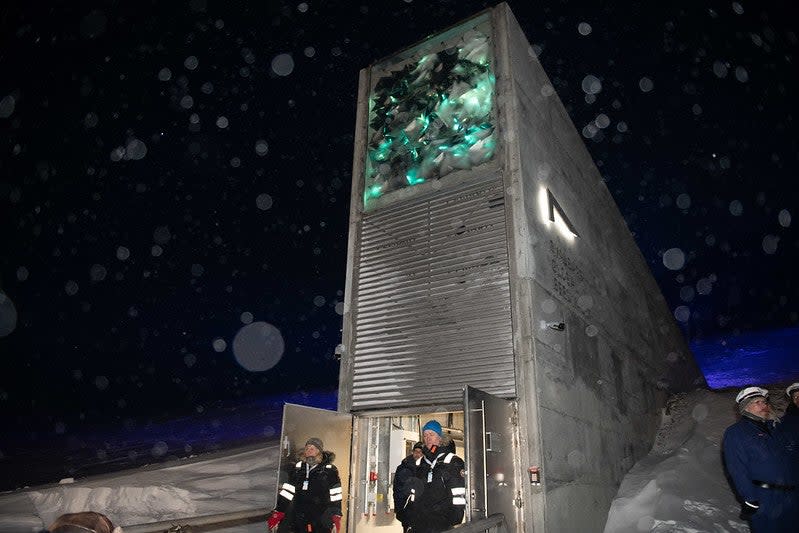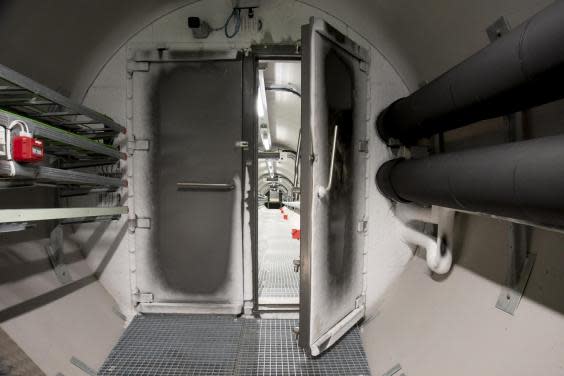The 'Doomsday' seed vault protecting the world's crops amid catastrophes like coronavirus

Rising out of the snowy expanse on a remote archipelago halfway between Norway and the North Pole, sits a granite edifice topped by a glowing art installation that resembles the Northern Lights.
This is the Svalbard Global Seed Vault, a long-term storage facility which houses the world’s largest collection of crop diversity.
In times of global catastrophe, like the raging Covid-19 pandemic, it stands as a quiet temple of security, protecting millions of back-ups of the world’s seed samples.
The Covid-19 pandemic poses no risk to the vault as there are no permanent staff at the Svalbard facility.
“In times of crisis like this, the world looks to these safety back-ups. It’s here that the need of the seed vault and other institutions like it become most evident,” Cierra Martin, Communications Officer for the Global Crop Diversity Trust, told The Independent.
“When things are going fine and people have a perceived sense of calm, it’s easy to forget about the value of having an insurance policy in place.
“For food and agriculture, there are small catastrophes happening around the world all the time. It doesn’t take a global pandemic to see the need for a back-up facility like the seed vault.”
Svalbard can be reached by scheduled flight, the farthest north you can fly, but there’s no public entry to the vault. The best you can hope for is a selfie at its imposing door.
Despite its Bond villain lair-exterior, the vault, reached by a 130-metre waterproof tunnel burrowed deep into the mountain, resembles a factory warehouse.
Blasted out of the rock, the space was nicknamed the "cathedral" after it was painted white to brighten the darkness.

Metal shelves are stacked high with boxes of seed samples from all corners of the globe.
Some 1.5m seed samples, each one around 500 seeds, make up 10,000 years of agricultural history. The vault has the capacity to store 4.5m samples in three vault rooms.
Seed samples from New Zealand, bearing the Kiwis’ flag, sit alongside an ornate box belonging to the Princess of Thailand. There’s a red container from North Korea and another holding seeds of South Korea.
“There are no political boundaries,” says Ms Martin.
Prince Charles has sent 27 wild plant species from meadows at the Royal Gardens at Highgrove to Svalbard. The Cherokee Nation were the first Native American tribe to deposit seed samples.
In 2015, a delegation from Parque de la Papa, of the Sacred Valley in Cusco, Peru, became the first indigenous community to deposit 750 potato seeds for long-term safekeeping.

Svalbard is geologically stable and far above sea level. The cold climate and permafrost means the seed samples are kept at minus 18C (-0.4F) and remain frozen without power.
It is owned by the Kingdom of Norway who built the facility for $9m. The Global Crop Diversity Trust provide support and the vault is operated by the Nordic Genetic Resources Center (NordGen) who maintain a database with a dizzying array of seed samples.
The Intergovernmental Panel on Climate Change (IPCC) and the Consultative Group on International Agricultural Research (CGIAR) warned last year that climate change will dramatically effect food production.
The climate crisis is affecting farmers’ ability to produce robust crops due to more extreme weather, higher temperatures, added salinity in the soil, new pests and disease outbreaks.
Some estimates predict a one-third decline in crop yields in the next two decades threatening famine and food shortages. More than 820 million people are undernourished around the world today.
Adding to the pressures on food demand, the global population is expected to grow by 2bn to nearly 10bn in the next 30 years.
Diversifying crops could offer a solution, making them more resilient to climate change and its myriad consequences.
The climate change crisis also poses a risk to more than 1,700 gene banks around the world which have their share of vulnerabilities.
Ms Martin said; “Floods, fires, earthquakes, even technical disruptions, like loss of energy or refrigerator malfunction, can result in seed banks losing valuable genetic material that’s not conserved anywhere else in the world.
“If that happens, those plant varieties go extinct. We lose the options for adapting our agriculture and making it more resilient in the face of higher temperatures and more unpredictable weather.”
Ms Martin points to the National Plant Genetic Resources Laboratory at the University of the Philippines which experienced a flood in 2006 and then caught fire six years later. Unfortunately, not all of their material had been backed up at the Svalbard vault.

She added: “The seed vault is a resource for all of us, all the time, regardless of a pandemic. But it becomes more tangible when you have a situation like we’re currently facing.
“It’s like a safety deposit box at the bank where seed banks send duplicate copies of their seeds.
“Our deposit agreement requires that the material is unique, important for food and agriculture and that the seed bank will share it with researchers and users globally.”
Svalbard vault acts as the global steward of the seeds which remain the property of their owners. The seed samples are scanned for security, undergo sanitary controls, then logged and given a home on the towering shelves.
“So when the worst happens, the seed banks haven’t lost all that material, they can retrieve it from the vault,” Ms Martin said.
Read more
How to help the elderly and vulnerable during the coronavirus
How to feel less anxious about the coronavirus
How to be productive when working from home during coronavirus


